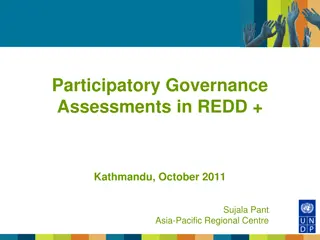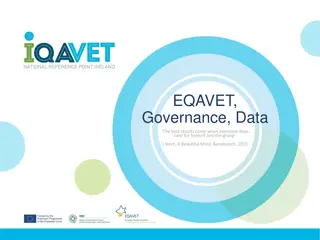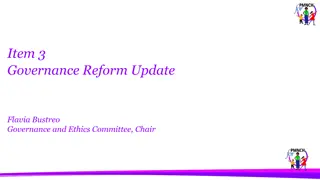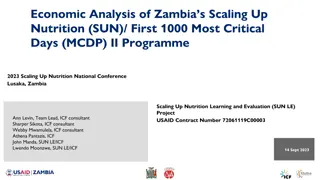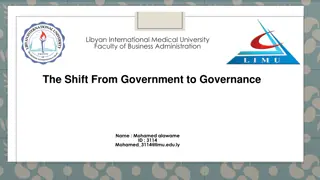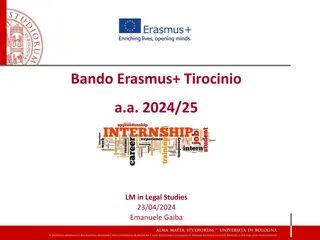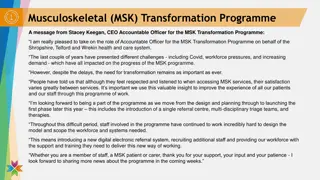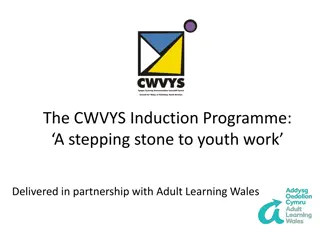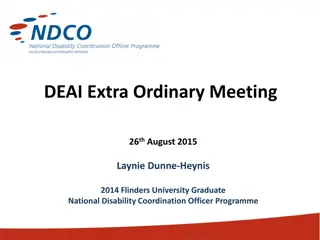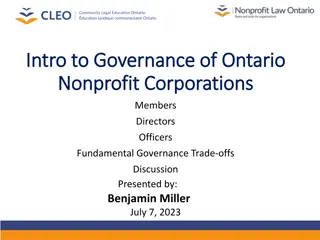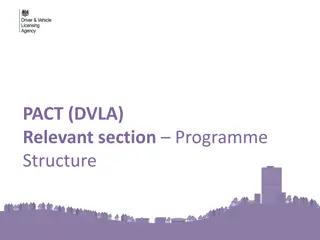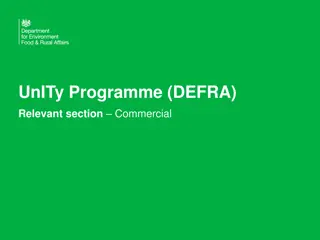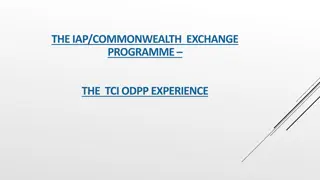Enhancing Governance through Transforming Governance Programme
Cause4 is a social business and B-Corporation offering advice, fundraising, training, and program development services. Their Transforming Governance Programme, conducted in partnership with Arts Council England, focuses on effective leadership, strategy, recruitment, and implementing Investment Principles. The programme comprises workshops covering various governance aspects, such as trustee leadership, strategy development, inclusivity, recruitment, and board collaboration. Opportunities for individuals to become board members are highlighted, emphasizing personal and professional growth. Quick facts about charities and trustees in England and Wales are also presented.
Download Presentation

Please find below an Image/Link to download the presentation.
The content on the website is provided AS IS for your information and personal use only. It may not be sold, licensed, or shared on other websites without obtaining consent from the author. Download presentation by click this link. If you encounter any issues during the download, it is possible that the publisher has removed the file from their server.
E N D
Presentation Transcript
v Transforming Governance Programme
About Cause4 About Cause4 Cause4 is a social business and B-Corporation, specialising in advice, fundraising, training and programme development. Led by Michelle Wright, we have extensive expertise in governance and in-depth knowledge of ACE s National Portfolio requirements. Our three core programmes are the Trustee Leadership Programme, Arts Fundraising & Philanthropy and Heritage Compass. Transforming Governance Delivered in partnership with Arts Council England, Transforming Governance will strengthen governance by focussing on effective leadership, strategy, recruitment and implementing the Investment Principles (IPs).
Transforming Governance: Workshop Outline Workshop Structure Each workshop will be delivered via Zoom, lasting 90 minutes (50 minutes content, 15 minutes guest speaker, 15 minutes breakout task and 10-minute break). There are seven workshops in total. Workshop 1a: Overview of Governance for Charity Trustees Workshop 1b: Overview of Governance for Non-Charities Workshop 2: Leading and Overseeing Strategy Workshop 3: Governance and the ACE Investment Principles Workshop 4: Developing Inclusivity and Relevance Workshop 5: Recruitment of Trustees and Succession Planning Workshop 6: Working with a Board
v Workshop 1a: Overview of Governance for Charity Trustees
Overview of Governance for Charity Trustees Understanding governance in the cultural sector What is governance and why is it important? The hallmarks of effective governance Key responsibilities of boards (legal, financial and ethical) Charity Commission requirements - compliance, prudence and care New regulations e.g. safeguarding
Why become a Board Member? Becoming a Board Member is a type of opportunity that can: Complement and add value to your career; Help you to gain new skills for personal and professional development; Lead to personal satisfaction associated with giving something back and making a difference to a cause that you care about; Provide opportunities to find new interests, broaden experiences and meet new people.
Quick Facts How many charities are there in England and Wales? How many Trustees are there? What sort of level of assets do they protect? Average age of a Board member? Who can t be a Trustee?
Quick Facts There are 921,364 Trustee positions held by 700,000 individuals in England and Wales, who are responsible for running 169,070 charities with a total income of 89.4bn (Charity Commission). Voluntary organisations with an annual income of 1m or more account for 81% of the sector s total income and make up only 3% of charities. Organisations with an income of 100,000 or less make up 82% of the sector in terms of the number of charities, but account for less than 5% of total income (NCVO). Men outnumber women Trustees two to one. The vast majority, 92%, are white British, and aged between 60-62 (20 years older than the average age in the UK). They are also above average in terms of both income and education.
Equality, Diversity & the Creative Case (2019-20) The most recent data on the workforce of the organisations in Arts Council England s National Portfolio. Most of the data is for the period 1st April 2019 31st March 2020. Governance: Across NPOs boards, the representation of Black, Asian and Ethnically Diverse people is 17% and disabled representation is at 9%. Women make up 49% of boards, with LGBT representation at 8%. Leadership: 11% of NPOs reported having a Chief Executive who was Black, Asian, or Ethnically Diverse, with 12% of Artistic Directors and 11% of Chairs. Disabled people make up 11% of Chief Executives, 8% of Artistic Directors and only 6% of Chairs. 17% of Chief Executives identify as LGBT, 12% of Artistic Directors and 8% of Chairs. Women make up 66% of Chief Executives, compared to 42% of Artistic Directors and Chairs.
Who cant be a Trustee? You must be at least 16 years old to be a Trustee of a charitable company or a charitable incorporated organisation (CIO), unless the organisation s governing document says you must be older. You must be at least 18 to be a Trustee of any other type of charity. You must not act as a Trustee if you are disqualified under the Charities Act. This includes if you: are disqualified as a company director have an unspent conviction for an offence involving dishonesty or deception (such as fraud) are an undischarged bankrupt or have a current composition or arrangement including an individual voluntary arrangement (IVA) with your creditors have been removed as a Trustee of any charity by the commission (or the court) because of misconduct or mismanagement have unspent convictions for bribery, terrorism and money laundering are on the sex offenders register Specific requirements when working with children and vulnerable adults.
Who can be a Board Member? In many cases people with learning difficulties or other mental health issues (through disability or ill-health) can be fully active as Board Members. One of the eligibility requirements is that Board members must be considered capable of managing their own affairs if they are to be considered capable of managing a charity. You can appoint someone who lives outside the UK as a trustee. This includes: Non-British citizens, people in the UK on temporary visas or seeking asylum, British citizens who live abroad The automatic disqualification rules do not disqualify people from all involvement with charities. There are other ways in which a disqualified person can be involved with charities, such as through appropriate employment in positions that do not count as senior manager positions , volunteering, or in advisory roles.
Legal Forms of Charities & Social Enterprises There are four main types of legal form for charities and social enterprises: Charitable Company Trust Charitable Incorporated Organisation Community Interest Company* * not always a non-profit model if limited by shares.
Legal Forms of Charities & Social Enterprises 1. Charitable Company This is a registered charity with limited liability bestowed on the directors or Trustees. The charitable company is responsible to both the Charity Commission and Companies House for its business. Charities can claim Gift Aid on donations received from individuals and companies can claim Corporation Tax Relief on donations made. This is currently the most popular form of governance arrangement and is relatively straightforward to administer, although the dual regulatory authorities make for some additional reporting requirements. 2. Trust Trusts are usually set up with a specific sum of money by a group of people who become its Trustees. This is often for a charity that distributes grants, where Trustees make decisions without involving a wider membership, and that will not employ staff or enter into contracts for work. Business is conducted in the name of the Trustees.
Legal Forms of Charities & Social Enterprises 3. Charitable Incorporated Organisation Recently introduced, this set of organisations is similar in nature to a charitable company. It reduces the administrative burden on charitable organisations through providing a structure which is responsible only to the Charity Commission but has its own legal identity (i.e. business is conducted in the name of the organisation not the Trustees themselves) and provides limited liability for the Trustees. CIOs are treated the same for tax purposes as registered charities. 4*. Community Interest Company This is a type of limited company designed specifically for social enterprises, which operate predominantly for the benefit of the community rather than for the benefit of the owners of the company. There is an asset lock , meaning that a CIC cannot be used solely for the personal gain of a particular person, or group of people. Directors of CICs can be routinely paid for their services unlike charity or CIO Trustees. Unlike other charity types that report to the Charity Commission, CICs are regulated by the Office of the Regulator of Community Interest Companies, located within Companies House.
Charities Social Contract Charities exist to benefit the public, not specific individuals. Charities, their Trustees and assets stand independent from the state and shareholder interests. They are exempt from most forms of income and capital gains tax where applied to charitable purposes and they pay reduced business rates. In return, they are restricted in what they can do and how they work. All charities must: Follow charity law, including Charity Commission guidance; Only undertake activities that are charitable according to the law; Be run by Trustees, who do not personally benefit from the charity; Report to the Charity Commission on activities and make information about their charity available for public inspection, including their charitable objects, a list of their Trustees, and their full set of accounts for the last five financial years (usually on the Charity Commission website).
Charitable Purposes To be a charity, an organisation must have exclusively charitable purposes and must operate for the public benefit. The Charities Act 2011 (consolidating 2006, 1993 and other laws) contains 13 descriptions of purposes: The prevention or relief of poverty; The advancement of education; The advancement of religion; The advancement of health or the saving of lives; The advancement of citizenship or community development; The advancement of the arts, culture, heritage or science; The advancement of amateur sport; The advancement of human rights, conflict resolution or reconciliation or the promotion of religious or racial harmony or equality and diversity; The advancement of environmental protection or improvement; The relief of those in need by reason of youth, age, ill-health, disability, financial hardship or other disadvantage; The advancement of animal welfare; The promotion of the efficiency of the armed forces of the Crown; or the efficiency of the police, fire and rescue services or ambulance services; Any other purposes charitable in law. It is important to note that a new Charities Act came into force in Autumn 2022 all Trustees are advised to read the full guidance (more information coming up in this course).
Charity Regulation Income and Thresholds With a few exceptions, charities with an income above 5,000 must register with the Charity Commission and are recorded on the online register of charities. Registered charities with an annual income over 10,000 must provide annual information to the Commission. Duties of the Charity Commission The Charity Commission is the independent regulator of charities in England and Wales. (The other UK regions have their own separate charity regulators.) Its strategic priorities are to develop: public confidence in the charity sector the sector s compliance and accountability the self-reliance of individual charities Recent changes at the Charity Commission have increased the weight of its guidance and emphasised its role in enforcement action.
Charity Regulation The Charity Commission regulates charities through: Only granting charitable status to organisations that can demonstrate they meet the criteria for being a charity; Ensuring charities meet their legal requirement to provide information on their activities each year; Making searchable information about each registered charity widely available; Providing online services and guidance to help charities run as effectively as possible; Taking timely and decisive action when there is malpractice or misconduct. Most charities in England and Wales must register with the Charity Commission, although some special types of charity do not have to register. The Charity Commission provides a wide range of advice and guidance to charities and their Trustees. The Commission has wide powers to intervene in the affairs of a charity where things have gone wrong.
Charity Commission Guidance The Charity Commission offers guidance to charities on both legal requirements and good practice to help them operate as effectively as possible and to prevent problems arising. When the Commission investigates cases of potential breach of trust, breach of duty, misconduct or mismanagement, it now takes account of evidence that Trustees have exposed the charity, its assets or beneficiaries to harm or undue risk by not following good practice. The Charity Commission has strengthened powers to look into problems affecting charities and make directions to put things right. In some circumstances Trustees may also be personally liable for any debts or losses that the charity faces as a result. This will depend on the circumstances and the type of governing document for the charity. However, personal liability of this kind is very rare, and usually only applies where the Trustees have acted dishonestly or recklessly. Trustees who have followed their duties and good practice will generally be protected.
Common mistakes made by Trustees Over half of the Charity Commission s investigations into complaints or concerns about charities involve basic failures of Trusteeship. Trustees failed to act according to their organisation's governing document; Failed to manage conflicts of interest; and Failed to oversee fundraising and finance effectively. These are all basic errors that could have been avoided with basic information and understanding of Trustees' roles and responsibilities.
Charity Commission Investigations In 2022-23, the charity commission received 2,969 new serious incident reports. This is a 14% reduction in the number of serious incident reports made by charities to the Commission compared with 2021-22. In 2022-23, the Commission removed 4,146 charities from the register, compared to 5,252 in the previous year. The Charity Commission describes a serious incident as being an adverse event - either actual or alleged - which either results in or risks significant harm to anyone who comes into contact with the charity through its work (for example, the charity s beneficiaries or staff), loss of the charity s money/assets, damage to its property or harm to the charity s work or reputation.
Charity Commission Investigations Kids Company The Charity Commission investigated the financial management of Kids Company in response to its sudden and high- profile closure in 2015 and its removal from the register in May 2021. In a report published March 2022, the Charity Commission reflected on the reasons for its failure, highlighting that the company was operating a high-risk business model characterised by a heavy dependence on grants and donations, reliance on a key individual for fundraising, low reserves, and a demand-led service . However, it stated that the trustees conduct did not amount to incompetence of a high degree . Gerson Support Group The organisation was set up to relieve sickness and to preserve and promote good health by providing support to cancer patients and to advance public education in the Gerson nutritional therapy . In the year 2021/22, Gerson Support Group was removed from the register of charities after the Charity Commission challenged whether it was able to fulfil the public benefit requirement. In 2018, the Charity Commission reviewed its approach to assessing the charitable status of CAM (Complementary Alternative Medicine) organisations. The review concluded that to satisfy the public benefit requirement and qualify for charitable status, an organisation that claims to offer a cure or treatment must provide objective scientific evidence.
Laws on Public Benefit All charities must operate for the public benefit. There are two aspects to this rule: 1. Benefit Aspect The benefit aspect is about whether the purpose is beneficial. To meet this requirement, a purpose must be beneficial and any detriment or harm that results from the purpose must not outweigh the benefit. 2. Public Aspect The public aspect is about who the purpose benefits. To meet this requirement, a purpose must benefit the public in general or a sufficient section of the public and not give rise to more than incidental personal benefit.
Laws on Public Benefit Trustees need to understand how their charity s purpose is beneficial and carry out the purpose so as to benefit the public in that way. The Charity Commission says that the Trustees must also identify and minimise risks of harm, and make sure that any harm that might arise is a minor consequence of carrying out the purpose. Most charities will benefit the general public, but some may choose to focus on certain beneficiaries. The Charity Commission acknowledges that Trustees may do this, provided that: They have proper reasons for doing so; They do not exclude poor and low-income people from benefit; The smaller group of people is a sufficient section of the public for the charity s purpose; They make decisions in accordance with the Charity Commission s separate guidance on Trustee decision-making.
The Role of Trustees Compliance, Prudence, Care Charity Trustees are responsible for the general control and management of the administration of a charity. They serve on the governing body of a charity and may be known as Trustees, directors, board members, governors or committee members. The great majority of Trustees serve as volunteers and receive no payment for their work. Trustees have, and must accept, ultimate responsibility for directing the affairs of a charity, and ensuring that it is solvent, well-run, and delivering the charitable outcomes for the benefit of the public for which it has been set up. Trustees must ensure that they carry out their charity's purposes for the public benefit, and act only in their charity s interests.
The Role of Trustees For compliance purposes, Trustees must: Ensure that the charity complies with charity law, and with the requirements of the Charity Commission as regulator; in particular to ensure that the charity prepares reports on what it has achieved and Annual Returns and accounts as required by law; Ensure that the charity does not breach any of the requirements or rules set out in its governing document and that it remains true to the charitable purpose and objects set out there; Comply with the requirements of other legislation and other regulators (if any) which govern the activities of the charity e.g. regarding fundraising; Act with integrity, deal with conflicts of interest, and avoid misuse of charity funds or assets
The Role of Trustees Compliance, Prudence, Care For the duty of prudence, Trustees must: Ensure that the charity is and will remain solvent; Use charitable funds and assets reasonably, and only in furtherance of the charity s objects; Avoid undertaking activities that might place the charity s endowment, funds, assets or reputation at undue risk; Take special care when investing the funds of the charity, or borrowing funds for the charity to use. For the duty of care, Trustees must: Use reasonable care and skill in their work as Trustees, using their personal skills and experience as needed to ensure that the charity is well-run and efficient; Consider getting appropriate external advice on all matters where there may be material risk to the charity, land assets or large investments are at stake, or where the Trustees may be in breach of their duties.
The Role of Trustees Compliance, Prudence, Care For the duty of care, Trustees must: Provide a safe and trusted environment. Safeguarding involves a duty of care to everyone who comes into contact with your charity, not just vulnerable beneficiaries like children and young people Set an organisational culture that prioritises safeguarding, so it is safe for people to report incidents and concerns in the knowledge they will be dealt with appropriately Have adequate safeguarding policies, procedures and measures to protect people and make sure these are made public, reviewed regularly and kept up to date Handle incidents as they arise. Report them to the relevant authorities including the police and the Charity Commission. Learn from these mistakes and put in place the relevant mechanisms to stop them happening again
Trustees and Safeguarding A vital area of work for Trustees is safeguarding: the range of measures in place to protect people in a charity, or those it comes into contact with, from abuse and maltreatment of any kind. The Charity Commission holds Trustees to account if things go wrong with safeguarding, as they did in the high-profile Haiti case for Oxfam. Safeguarding should be an item on the agenda of every board meeting. For all charities, the Charity Commission expects that as a minimum: policies are agreed by trustees; are regularly updated; reflect statutory guidance and national and local practice; and are supported by an implementation plan. The policy should be publicly available, to provide reassurance and to enable constructive feedback from beneficiaries and other stakeholders.
Lead Trustee for Safeguarding If your charity works with children or adults at risk, the Charity Commission expects you to appoint a Lead Trustee for Safeguarding. However, a wider range of charities might also find this beneficial. Safeguarding remains the responsibility of all Trustees, but the Lead Trustee for Safeguarding usually takes on three main sets of duties related to safeguarding in addition to their wider responsibilities as a trustee. Strategic Duties considering how the charity s strategic plans reflect safeguarding legislation and which specific regulations will apply due to your activity areas Policy Duties ensuring that safeguarding policies and procedures are reviewed regularly and improved based on data and benchmarking Culture Duties champion safeguarding throughout the organisations, and support understanding of policies for staff, volunteers, and beneficiaries
The Essential Trustee 6 Main Duties Charity Commission 1. Ensure your charity is carrying out its purposes for the public benefit 2. Comply with your charity s governing document and the law 3. Act in your charity s best interests 4. Ensure your charity is accountable 5. Manage your charity s resources responsibly 6. Act with reasonable care and skill
Charity Governance Code A clear set of governance standards Launched in July 2017 by NCVO along with steering group partners, the Code s aim is to help charities and Trustees achieve high standards of governance. 7 Principles assuming the charity is meeting legal and regulatory responsibilities, each has: Rationale Key Outcomes Recommended Practice dependent on size of the charity The Governance Code steering group committed to reviewing the content every three years to make sure it reflects changes in society, best practice and remains relevant to the sector. Updates were made in 2020, and the next review is due in 2023.
Charity Governance Code changes Changes from the previous code include: An expectation that the Board will internally and externally review its own performance. Nine-year term limit (unless good reason) & term limits are crucial to accountability. Importance of board diversity. Boards involving stakeholders in key decisions and operating openly. Importance of the Chair and Vice Chair for good governance. Increased oversight for large charities when dealing with external stakeholders. That the Board evaluates a charity s impact.
Trustee and Board Member Types In the charity sector, there are a number of stereotypes often seen on Boards: Name-droppers Talk about their connections but never act on them; Seagulls Swoop in, make a mess and leave; Frustrated CEOs' - Those that want to run the organisation themselves; Glory-hunters - Don't do anything, but like their name on the letterhead Skills + Time + Energy + Culture
Principles of Good Governance Clarity over the purpose and direction of an organisation an effective organisation is clear about its vision, mission and values, and uses them to direct its work; A strong Board an effective organisation is run by a clearly identifiable Board that has the right balance of skills and experience, acts in the best interests of the organisation and its beneficiaries, understands its responsibilities and has systems in place to exercise them properly; Fit for purpose the structure, policies and procedures of an effective organisation enable it to achieve its purposes and mission and deliver its services efficiently; Learning and improving an effective organisation is always seeking to improve its performance and efficiency, and to learn new and better ways of delivering its purposes, through self- assessment and external evaluation, which feed into planning processes and influence its future direction; Financially sound and prudent an effective organisation has the financial and additional resources needed to deliver its purposes and mission, and controls and uses them so as to achieve its potential; Accountable and transparent an effective organisation is accountable to the public and others, through easily understandable and transparent policies, procedures and practices.
Governance vs. Management Governance Board s role How Boards make decisions, allocate resources, achieve results, and are held accountable Management Executive function Day-to-day management of tasks and details of running an organisation The Board has established clear levels of delegated authority within which: Some decisions are reserved to the board The CEO is empowered to make decisions and delegate authority to the staff for the day- to-day operation of the charity The CEO is required to escalate high risk and /or high impact issues for the timely attention and consideration of the board
Financial Responsibility Depending on the size of the organisation, the day-to-day responsibility for financial matters will usually sit with a Finance Director or the CEO who will report to the Board. Board members have a number of legal responsibilities in relation to accounting and financial reporting. These include: Keeping 'sufficient' accounting records to explain all transactions and show the charity's financial position; Preparing an annual report and statutory accounts meeting legal requirements; Considering the need for a reserves policy, managing the level of reserves held and the disclosure of any reserves policy in the Annual Report; Formally approving the Annual Report and accounts.
Financial Responsibility Ensuring that accounts are subjected to any external scrutiny required by law or by the charity's governing document; Ensuring that the Trustees' Annual Report, accounts and annual return are filed on time with the Charity Commission where filing is required by law and, if the charity is a company, also filed with Companies House; Meeting requests from the public for copies of the charity's most recent Trustees' annual report and accounts; Safeguarding the assets of the charity and ensuring proper application of resources; Taking steps to prevent and detect bribery, fraud, financial abuse and other irregularities.
Financial Responsibility Most Boards will appoint a Treasurer to ensure that all of these legal responsibilities are covered. A Treasurer s role will involve: Overseeing the financial affairs of the organisation and ensuring that they are legal, in accordance with the governing document and within accepted accounting practice; Ensuring proper records are kept and effective financial procedures are in place; Monitoring and reporting on the financial health of the organisation; Overseeing the production of financial reports/returns, accounts and audits; Liaising with relevant staff or volunteers to ensure the financial viability of the organisation; Making fellow committee members aware of their financial obligations and taking a lead in interpreting financial data to them; Regularly reporting the financial position of the organisation at meetings (through the balance sheet, cash flow, fundraising performance etc.); Overseeing the production of an annual budget and proposing its adoption at the last meeting of the previous financial year; Ensuring proper records are kept and that effective financial procedures and controls are in place for purchasing systems, petty cash and salaries; Appraising the financial viability of plans, proposals and feasibility studies; Leading on appointing and liaising with auditors/an independent examiner.
Managing Risk Trustees have a duty to protect their charity's assets and resources. All charities face risks, and insurance can be an appropriate way of protecting them against any loss, damage or liability arising from these risks. Charities that employ staff are required by law to buy employers' liability insurance. Charities that own or operate motor vehicles are required by law to buy motor insurance. Examples of insurance that might be needed to cover a charity's property against loss or damage are: Buildings insurance; Contents insurance; Event insurance. Examples of types of insurance that might be needed to cover against a charity's third party liabilities are: Professional indemnity insurance; Public liability insurance.
Managing Risk Charities are advised to treat volunteers in the same way as they do their employees and to ensure that they are covered by the usual types of insurance that a charity might buy, such as employers' liability or public liability insurance. A charity should ensure that its volunteers are protected from harm as a result of any negligence on its part. Also, both the charity and its volunteers should be covered in the event of a third party being injured through the actions of a volunteer. The charity should check any insurance policy to see: That it definitely includes volunteers; How the term 'volunteer' is defined for the purposes of that policy; Whether any upper or lower age limits apply; That the policy covers the types of activities that the volunteers will be undertaking. The charity should keep accurate records of the volunteers it uses who fall within the definitions in any insurance policy that it has.
Breakout Seven Deadly Sins of Boards John Williams, Civil Society, 2016
Discussion What Deadly Sins have you experienced or witnessed on Trustee Boards? What could be improved or implemented to help? Post 2-3 summary points in the chat post-session
v Transforming Governance Programme





